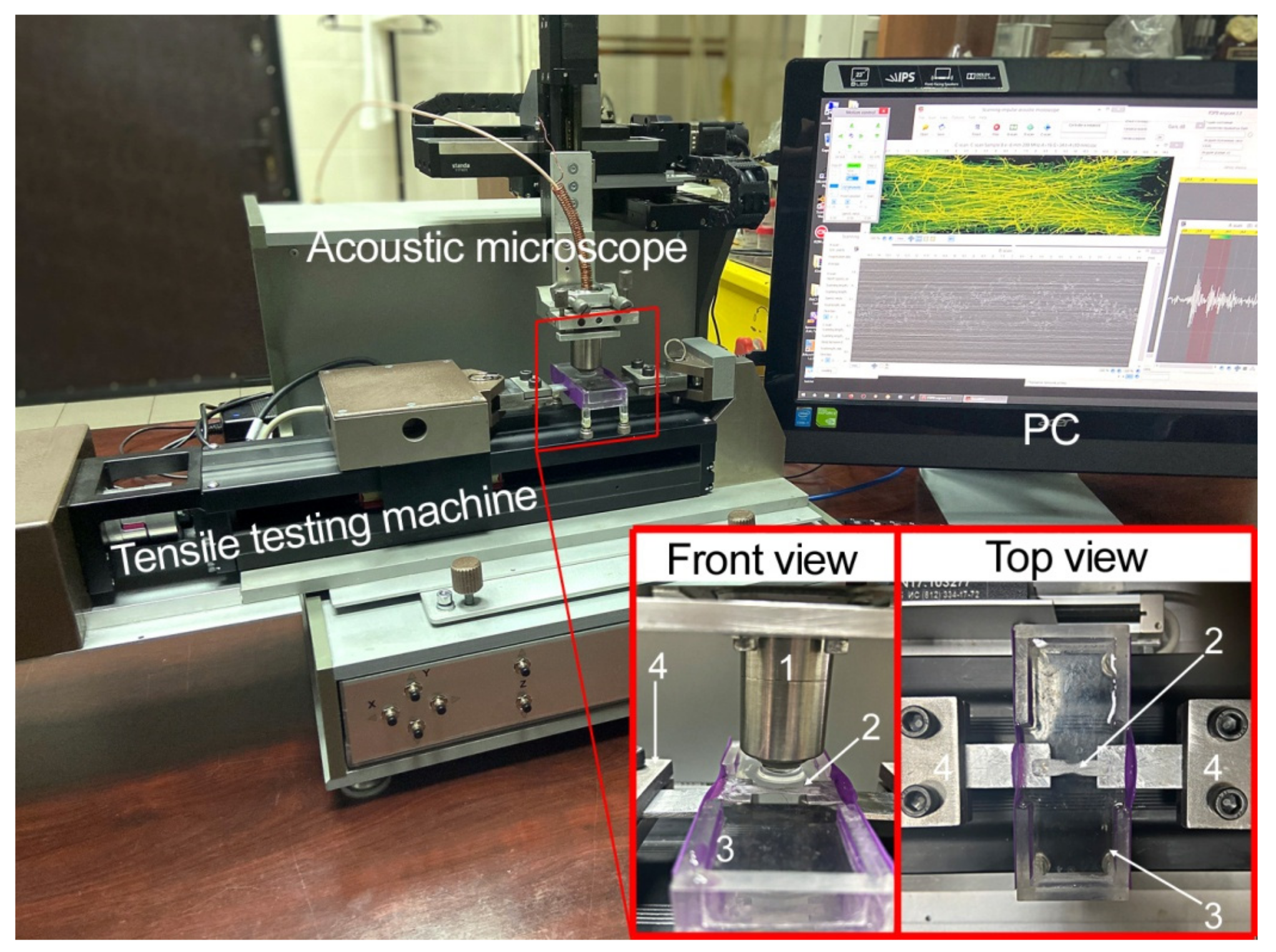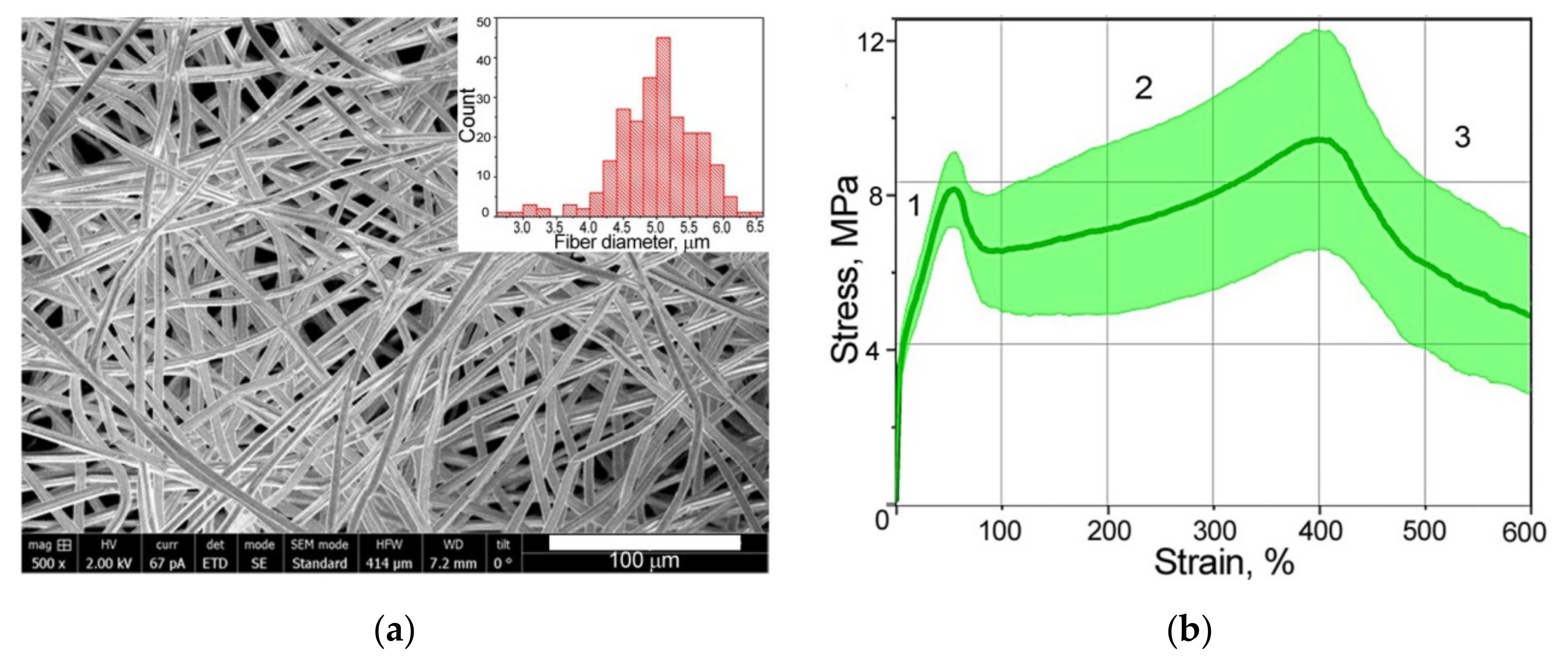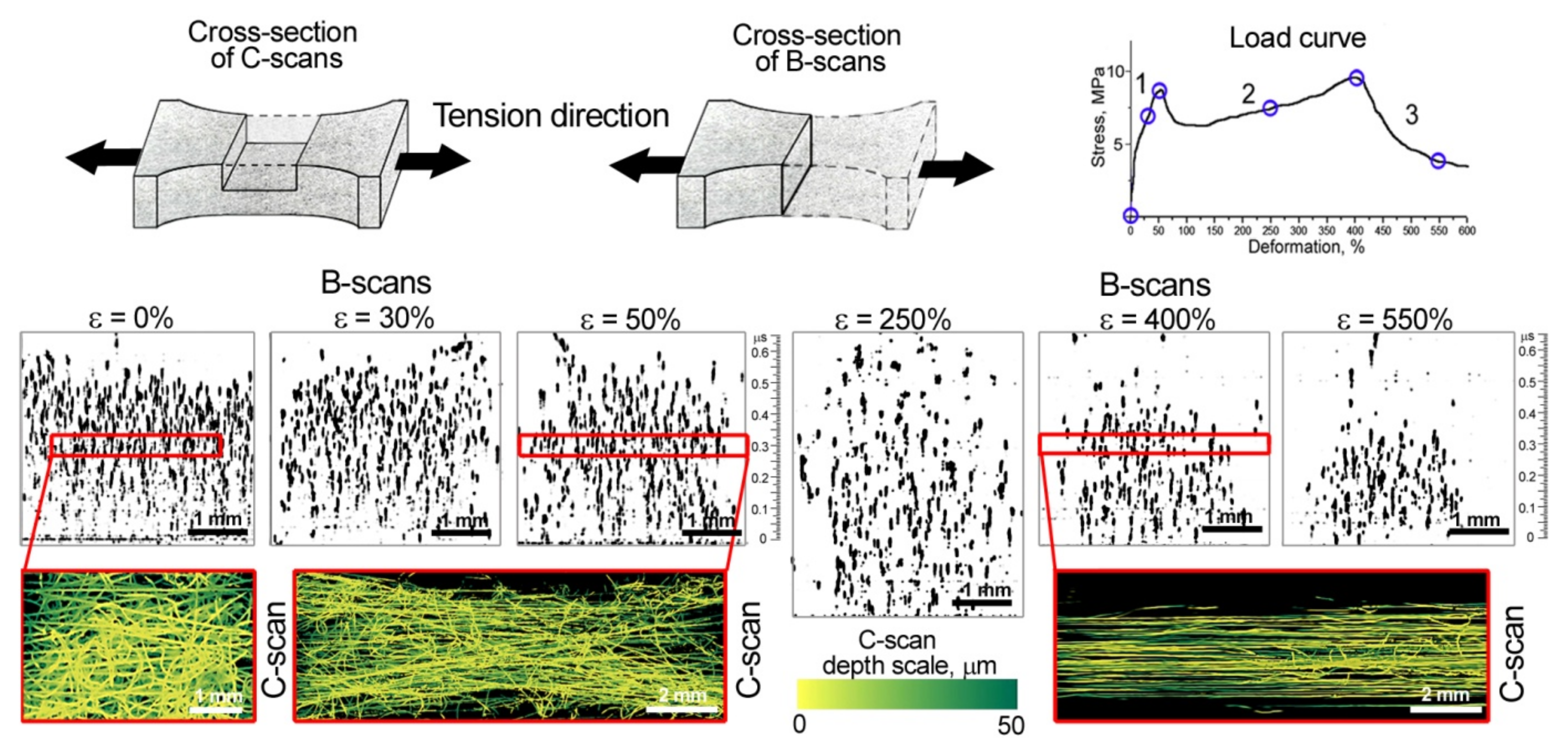How the Nonwoven Polymer Volume Microstructure Is Transformed under Tension in an Aqueous Environment
Abstract
:1. Introduction
2. Materials and Methods
2.1. Specimen Preparation
2.2. Mechanical Tests
2.3. Acoustic Microscopy
3. Results
3.1. Nonwoven Sample Characteristics
3.2. Imaging of Individual Fibers under Tension
3.3. Evolution of Microstructure in the Volume of Scaffolds under Tension
3.4. Estimation of Fiber Quantity in Vertical Cross-Section at Different Deformations
4. Discussion
- under elastic deformation, the unwound fibers retain their original diameter and structure, and are oriented along the tensile axis (Figure 4a,b);
- when most of the stretched fibers of the original diameter unbend (Figure 4c), the nonwoven scaffold reaches the first maximum on the stress–strain curve. The elastic region ends;
- the maximal load (second peak) on the scaffolds arises when the most of the thinned fibers are aligned over the axis (Figure 4e). The fibers undergo deformation close to tensile strength. The samples lost their satiability after the instant breaks of the numerous thinned fibers;
- the last stage of elongation corresponds to lengthening and breaking of most of the initially curved fibers. They were imaged with the same brightness (Figure 4f) as fibers of the initial structure (Figure 4a), while the previously elongated fibers looked darker (Figure 4f). The fibers held the load, elongated and broke one by one. Therefore, the load curves of the specimens each showed a long ending.
5. Conclusions
Author Contributions
Funding
Institutional Review Board Statement
Informed Consent Statement
Data Availability Statement
Acknowledgments
Conflicts of Interest
References
- Liu, W.; Thomopoulos, S.; Xia, Y. Electrospun Nanofi Bers for Regenerative Medicine. Adv. Healthcare Mater. 2012, 1, 10–25. [Google Scholar] [CrossRef] [PubMed]
- Ding, J.; Zhang, J.; Li, J.; Li, D.; Xiao, C.; Xiao, H.; Yang, H.; Zhuang, X.; Chen, X. Electrospun Polymer Biomaterials. Prog. Polym. Sci. 2019, 90, 1–34. [Google Scholar] [CrossRef]
- Trevisol, T.C.; Langbehn, R.K.; Battiston, S.; Immich, A.P.S. Nonwoven Membranes for Tissue Engineering: An Overview of Cartilage, Epithelium, and Bone Regeneration. J. Biomater. Sci. Polym. Ed. 2019, 30, 1026–1049. [Google Scholar] [CrossRef] [PubMed]
- Rickel, A.P.; Deng, X.; Engebretson, D.; Hong, Z. Electrospun Nanofiber Scaffold for Vascular Tissue Engineering. Mater. Sci. Eng. C 2021, 129, 112373. [Google Scholar] [CrossRef] [PubMed]
- Sánchez-Cid, P.; Jiménez-Rosado, M.; Romero, A.; Pérez-Puyana, V. Novel Trends in Hydrogel Development for Biomedical Applications: A Review. Polymers 2022, 14, 3023. [Google Scholar] [CrossRef] [PubMed]
- Agmon, G.; Christman, K.L. Controlling Stem Cell Behavior with Decellularized Extracellular Matrix Scaffolds. Curr. Opin. Solid State Mater. Sci. 2016, 20, 193–201. [Google Scholar] [CrossRef] [PubMed]
- Kim, H.S.; Pourdeyhimi, B. The Role of Structure on Mechanical Properties of Nonwoven Fabrics. Int. Nonwovens J. 2001, os-10, 1558925001OS-01. [Google Scholar] [CrossRef]
- Rizvi, M.S.; Kumar, P.; Katti, D.S.; Pal, A. Mathematical Model of Mechanical Behavior of Micro/Nanofibrous Materials Designed for Extracellular Matrix Substitutes. Acta Biomater. 2012, 8, 4111–4122. [Google Scholar] [CrossRef]
- Kumar, P.; Vasita, R. Understanding the Relation between Structural and Mechanical Properties of Electrospun Fiber Mesh through Uniaxial Tensile Testing. J. Appl. Polym. Sci. 2017, 134, 1–11. [Google Scholar] [CrossRef]
- Chavoshnejad, P.; Razavi, M.J. Effect of the Interfiber Bonding on the Mechanical Behavior of Electrospun Fibrous Mats. Sci. Rep. 2020, 10, 7709. [Google Scholar] [CrossRef]
- Rebrov, I.E.; Lukanina, K.I.; Grigoriev, T.E.; Bakirov, A.V.; Krasheninnikov, S.V.; Dmitryakov, P.V.; Kamyshinsky, R.A.; Antipova, C.G.; Chvalun, S.N.; Khomich, V.Y. Enhanced Electrospinning: Multi-Level Fiber Alignment by Control of Electrohydrodynamic Jet Motion for Tissue Engineering. Chem. Eng. J. 2021, 418, 126561. [Google Scholar] [CrossRef]
- Lange, J.R.; Fabry, B. Cell and Tissue Mechanics in Cell Migration. Exp. Cell Res. 2013, 319, 2418–2423. [Google Scholar] [CrossRef] [PubMed]
- Ahmed, M.; Ramos, T.; Wieringa, P.; Van Blitterswijk, C.; De Boer, J.; Moroni, L. Geometric Constraints of Endothelial Cell Migration on Electrospun Fibres. Sci. Rep. 2018, 8, 6386. [Google Scholar] [CrossRef] [PubMed]
- Metwally, S.; Karbowniczek, J.E.; Szewczyk, P.K.; Marzec, M.M.; Gruszczyński, A.; Bernasik, A.; Stachewicz, U. Single-Step Approach to Tailor Surface Chemistry and Potential on Electrospun PCL Fibers for Tissue Engineering Application. Adv. Mater. Interfaces 2019, 6, 1801211. [Google Scholar] [CrossRef]
- Chew, S.Y.; Mi, R.; Hoke, A.; Leong, K.W. The Effect of the Alignment of Electrospun Fibrous Scaffolds on Schwann Cell Maturation. Biomaterials 2008, 29, 653–661. [Google Scholar] [CrossRef]
- Doyle, A.D.; Yamada, K.M. Mechanosensing via Cell-Matrix Adhesions in 3D Microenvironments. Exp. Cell Res. 2016, 343, 60–66. [Google Scholar] [CrossRef]
- Kang, Y.; Wang, C.; Qiao, Y.; Gu, J.; Zhang, H.; Peijs, T.; Kong, J.; Zhang, G.; Shi, X. Tissue-Engineered Trachea Consisting of Electrospun Patterned Sc-PLA/GO- g-IL Fibrous Membranes with Antibacterial Property and 3D-Printed Skeletons with Elasticity. Biomacromolecules 2019, 20, 1765–1776. [Google Scholar] [CrossRef]
- Wang, X.; Ding, B.; Li, B. Biomimetic Electrospun Nanofibrous Structures for Tissue Engineering. Mater. Today 2013, 16, 229–241. [Google Scholar] [CrossRef]
- Qin, S.; Clark, R.A.F.; Rafailovich, M.H. Establishing Correlations in the En-Mass Migration of Dermal Fibroblasts on Oriented Fibrillar Scaffolds. Acta Biomater. 2015, 25, 230–239. [Google Scholar] [CrossRef]
- Koh, C.T.; Strange, D.G.T.; Tonsomboon, K.; Oyen, M.L. Failure Mechanisms in Fibrous Scaffolds. Acta Biomater. 2013, 9, 7326–7334. [Google Scholar] [CrossRef] [Green Version]
- Hartmann-Fritsch, F.; Biedermann, T. Murine Models for in Vivo Evaluation of New Biomaterials for Skin Scaffolds; Elsevier: Amsterdam, The Netherlands, 2019; ISBN 9780081025468. [Google Scholar]
- Hodge, J.; Quint, C. Tissue Engineered Vessel from a Biodegradable Electrospun Scaffold Stimulated with Mechanical Stretch. Biomed. Mater. 2020, 15, 055006. [Google Scholar] [CrossRef] [PubMed]
- Tan, E.P.S.; Ng, S.Y.; Lim, C.T. Tensile Testing of a Single Ultrafine Polymeric Fiber. Biomaterials 2005, 26, 1453–1456. [Google Scholar] [CrossRef] [PubMed]
- Kennedy, K.M.; Bhaw-Luximon, A.; Jhurry, D. Cell-Matrix Mechanical Interaction in Electrospun Polymeric Scaffolds for Tissue Engineering: Implications for Scaffold Design and Performance. Acta Biomater. 2017, 50, 41–55. [Google Scholar] [CrossRef] [PubMed]
- Stachewicz, U.; Szewczyk, P.K.; Kruk, A.; Barber, A.H.; Czyrska-Filemonowicz, A. Pore Shape and Size Dependence on Cell Growth into Electrospun Fiber Scaffolds for Tissue Engineering: 2D and 3D Analyses Using SEM and FIB-SEM Tomography. Mater. Sci. Eng. C 2019, 95, 397–408. [Google Scholar] [CrossRef]
- Romanova, O.A.; Grigor’ev, T.E.; Goncharov, M.E.; Rudyak, S.G.; Solov’yova, E.V.; Krasheninnikov, S.T.; Saprykin, V.P.; Sytina, E.V.; Chvalun, S.N.; Pal’tsev, M.A.; et al. Chitosan as a Modifying Component of Artificial Scaffold for Human Skin Tissue Engineering. Bull. Exp. Biol. Med. 2015, 159, 557–566. [Google Scholar] [CrossRef]
- Mohammadzadehmoghadam, S.; LeGrand, C.F.; Wong, C.-W.; Kinnear, B.F.; Dong, Y.; Coombe, D.R. Fabrication and Evaluation of Electrospun Silk Fibroin/Halloysite Nanotube Biomaterials for Soft Tissue Regeneration. Polymers 2022, 14, 3004. [Google Scholar] [CrossRef]
- Rodina, A.V.; Tenchurin, T.K.; Saprykin, V.P.; Shepelev, A.D.; Mamagulashvili, V.G.; Grigor’ev, T.E.; Moskaleva, E.Y.; Chvalun, S.N.; Severin, S.E. Proliferative and differentiation potential of multipotent mesenchymal stem cells cultured on biocompatible polymer scaffolds with various physicochemical characteristics. Bull. Exp. Biol. Med. 2017, 162, 488–495. [Google Scholar] [CrossRef]
- Baker, B.M.; Gee, A.O.; Metter, R.B.; Nathan, A.S.; Marklein, R.A.; Burdick, J.A.; Mauck, R.L. The Potential to Improve Cell Infiltration in Composite Fiber-Aligned Electrospun Scaffolds by the Selective Removal of Sacrificial Fibers. Biomaterials 2008, 29, 2348–2358. [Google Scholar] [CrossRef]
- Gaharwar, A.K.; Nikkhah, M.; Sant, S.; Khademhosseini, A. Anisotropic Poly (Glycerol Sebacate)-Poly (-Caprolactone) Electrospun Fibers Promote Endothelial Cell Guidance. Biofabrication 2015, 7, 15001. [Google Scholar] [CrossRef]
- Yin, Z.; Chen, X.; Chen, J.L.; Shen, W.L.; Hieu Nguyen, T.M.; Gao, L.; Ouyang, H.W. The Regulation of Tendon Stem Cell Differentiation by the Alignment of Nanofibers. Biomaterials 2010, 31, 2163–2175. [Google Scholar] [CrossRef]
- Baiguera, S.; Del, C.; Lucatelli, E.; Kuevda, E.; Boieri, M.; Mazzanti, B.; Bianco, A.; Macchiarini, P. Biomaterials Electrospun Gelatin Scaffolds Incorporating Rat Decellularized Brain Extracellular Matrix for Neural Tissue Engineering. Biomaterials 2014, 35, 1205–1214. [Google Scholar] [PubMed]
- Engelmayr, G.C.; Rabkin, E.; Sutherland, F.W.H.; Schoen, F.J.; Mayer, J.E.; Sacks, M.S. The Independent Role of Cyclic Flexure in the Early in Vitro Development of an Engineered Heart Valve Tissue. Biomaterials 2005, 26, 175–187. [Google Scholar] [PubMed]
- Farukh, F.; Demirci, E.; Sabuncuoglu, B.; Acar, M.; Pourdeyhimi, B.; Silberschmidt, V.V. Mechanical Behaviour of Nonwovens: Analysis of Effect of Manufacturing Parameters with Parametric Computational Model. Comput. Mater. Sci. 2014, 94, 8–16. [Google Scholar] [CrossRef]
- dos Santos, D.M.; Leite, I.S.; Bukzem, A.d.L.; de Oliveira Santos, R.P.; Frollini, E.; Inada, N.M.; Campana-Filho, S.P. Nanostructured Electrospun Nonwovens of Poly(ε-Caprolactone)/Quaternized Chitosan for Potential Biomedical Applications. Carbohydr. Polym. 2018, 186, 110–121. [Google Scholar] [PubMed]
- Zhang, M.; Chen, Y.; Chiang, F.P.; Gouma, P.I.; Wang, L. Modeling the Large Deformation and Microstructure Evolution of Nonwoven Polymer Fiber Networks. J. Appl. Mech. Trans. ASME 2019, 86, 011010. [Google Scholar]
- Yano, T.; Higaki, Y.; Tao, D.; Murakami, D.; Kobayashi, M.; Ohta, N.; Koike, J.I.; Horigome, M.; Masunaga, H.; Ogawa, H.; et al. Orientation of Poly(Vinyl Alcohol) Nanofiber and Crystallites in Non-Woven Electrospun Nanofiber Mats under Uniaxial Stretching. Polymer 2012, 53, 4702–4708. [Google Scholar] [CrossRef]
- Martínez-Hergueta, F.; Ridruejo, A.; González, C.; Llorca, J. Deformation and Energy Dissipation Mechanisms of Needle-Punched Nonwoven Fabrics: A Multiscale Experimental Analysis. Int. J. Solids Struct. 2015, 64, 120–131. [Google Scholar] [CrossRef]
- Chen, N.; Koker, M.K.A.; Uzun, S.; Silberstein, M.N. In-Situ X-Ray Study of the Deformation Mechanisms of Non-Woven Polypropylene. Int. J. Solids Struct. 2016, 97–98, 200–208. [Google Scholar]
- Jeon, S.Y.; Na, W.J.; Choi, Y.O.; Lee, M.G.; Kim, H.E.; Yu, W.R. In Situ Monitoring of Structural Changes in Nonwoven Mats under Tensile Loading Using X-Ray Computer Tomography. Compos. Part A Appl. Sci. Manuf. 2014, 63, 1–9. [Google Scholar]
- Maksimcuka, J.; Obata, A.; Sampson, W.W.; Blanc, R.; Gao, C.; Withers, P.J.; Tsigkou, O.; Kasuga, T.; Lee, P.D.; Poologasundarampillai, G. X-Ray Tomographic Imaging of Tensile Deformation Modes of Electrospun Biodegradable Polyester Fibers. Front. Mater. 2017, 4, 1–11. [Google Scholar]
- Morokov, E.; Khramtsova, E.; Kuevda, E.; Gubareva, E.; Grigoriev, T.; Lukanina, K.; Levin, V. Noninvasive Ultrasound Imaging for Assessment of Intact Microstructure of Extracellular Matrix in Tissue Engineering. Artif. Organs 2019, 43, 1104–1110. [Google Scholar] [PubMed]
- Morokov, E.; Zykova, A.; Tyubaeva, P. Nonwoven Scaffolds Under Tension: In Situ High-Resolution Ultrasound Observation of Microstructure Evolution in the Volume. Adv. Eng. Mater. 2021, 23, 2001373. [Google Scholar] [CrossRef]
- Bhartiya, A.; Madi, K.; Disney, C.M.; Courtois, L.; Jupe, A.; Zhang, F.; Bodey, A.J.; Lee, P.; Rau, C.; Robinsona, I.K.; et al. Phase-Contrast 3D Tomography of HeLa Cells Grown in PLLA Polymer Electrospun Scaffolds Using Synchrotron X-Rays Bhartiya A. J. Synchrotron Radiat. 2020, 27, 158–163. [Google Scholar] [CrossRef] [PubMed]
- Gharibi, R.; Yeganeh, H.; Gholami, H.; Hassan, Z.M. Aniline Tetramer Embedded Polyurethane/Siloxane Membranes and Their Corresponding Nanosilver Composites as Intelligent Wound Dressing Materials. RSC Adv. 2014, 4, 62046–62060. [Google Scholar] [CrossRef]
- Gao, X.; Wen, M.; Liu, Y.; Hou, T.; An, M. Mechanical Performance and Cyocompatibility of PU/PLCL Nanofibrous Electrospun Scaffolds for Skin Regeneration. Eng. Regen. 2022, 3, 53–58. [Google Scholar]
- Lopresti, F.; Carfì Pavia, F.; Vitrano, I.; Kersaudy-Kerhoas, M.; Brucato, V.; La Carrubba, V. Effect of Hydroxyapatite Concentration and Size on Morpho-Mechanical Properties of PLA-Based Randomly Oriented and Aligned Electrospun Nanofibrous Mats. J. Mech. Behav. Biomed. Mater. 2020, 101, 103449. [Google Scholar]
- Shahali, Z.; Karbasi, S.; Avadi, M.R.; Semnani, D.; Naghash Zargar, E.; HashemiBeni, B. Evaluation of Structural, Mechanical, and Cellular Behavior of Electrospun Poly-3-Hydroxybutyrate Scaffolds Loaded with Glucosamine Sulfate to Develop Cartilage Tissue Engineering. Int. J. Polym. Mater. Polym. Biomater. 2017, 66, 589–602. [Google Scholar] [CrossRef]
- Tyubaeva, P.; Varyan, I.; Lobanov, A.; Olkhov, A.; Popov, A. Effect of the Hemin Molecular Complexes on the Structure and Properties of the Composite Electrospun Materials Based on Poly(3-Hydroxybutyrate). Polymers 2021, 13, 4024. [Google Scholar] [CrossRef]
- Silberstein, M.N.; Pai, C.L.; Rutledge, G.C.; Boyce, M.C. Elasticplastic Behavior of Non-Woven Fibrous Mats. J. Mech. Phys. Solids 2012, 60, 295–318. [Google Scholar] [CrossRef]
- Domaschke, S.; Zündel, M.; Mazza, E.; Ehret, A.E. A 3D Computational Model of Electrospun Networks and Its Application to Inform a Reduced Modelling Approach. Int. J. Solids Struct. 2019, 158, 76–89. [Google Scholar]
- Rawal, A. Excluded Volume and Its Relation to the Theory of Fiber-Fiber Contacts. Mech. Mater. 2021, 160, 103901. [Google Scholar] [CrossRef]
- Lukanina, K.; Grigor’ev, T.; Tenchurin, T.; Shepelev, A.; Chvalun, S. Nonwoven Materials Produced by Electrospinning for Modern Medical Technologies (Review). Fibre Chem. 2017, 49, 205–216. [Google Scholar] [CrossRef]
- Morel, A.; Domaschke, S.; Urundolil Kumaran, V.; Alexeev, D.; Sadeghpour, A.; Ramakrishna, S.N.; Ferguson, S.J.; Rossi, R.M.; Mazza, E.; Ehret, A.E.; et al. Correlating Diameter, Mechanical and Structural Properties of Poly(L-Lactide) Fibres from Needleless Electrospinning. Acta Biomater. 2018, 81, 169–183. [Google Scholar] [PubMed]
- Migliaresi, C.; De Lollis, A.; Fambri, L.; Cohn, D. The Effect of Thermal History on the Crystallinity of Different Molecular Weight PLLA Biodegradable Polymers. Clin. Mater. 1991, 8, 111–118. [Google Scholar] [CrossRef]
- Narayanan, G.; Vernekar, V.N.; Kuyinu, E.L.; Laurencin, C.T. Poly (Lactic Acid)-Based Biomaterials for Orthopaedic Regenerative Engineering. Adv. Drug Deliv. Rev. 2016, 107, 247–276. [Google Scholar]
- Ker, R.F. The Design of Soft Collagenous Load-Bearing Tissues. J. Exp. Biol. 1999, 202, 3315–3324. [Google Scholar]





| Deformation, % | 0 | 30 | 50 | 250 | 400 | 550 |
|---|---|---|---|---|---|---|
| Fiber volume fraction in the central part ± 10, ×0.1 mm−2 | 145 | 94 | 67 | 40 | 54 | 40 |
| Average thickness of scaffold, µm | 380 | 350 | 320 | 450 | 250 | 140 |
| Average width of scaffold, mm | 5 | 3.7 | 3.3 | 3.3 | 3 | 2.4 |
Publisher’s Note: MDPI stays neutral with regard to jurisdictional claims in published maps and institutional affiliations. |
© 2022 by the authors. Licensee MDPI, Basel, Switzerland. This article is an open access article distributed under the terms and conditions of the Creative Commons Attribution (CC BY) license (https://creativecommons.org/licenses/by/4.0/).
Share and Cite
Khramtsova, E.; Morokov, E.; Antipova, C.; Krasheninnikov, S.; Lukanina, K.; Grigoriev, T. How the Nonwoven Polymer Volume Microstructure Is Transformed under Tension in an Aqueous Environment. Polymers 2022, 14, 3526. https://doi.org/10.3390/polym14173526
Khramtsova E, Morokov E, Antipova C, Krasheninnikov S, Lukanina K, Grigoriev T. How the Nonwoven Polymer Volume Microstructure Is Transformed under Tension in an Aqueous Environment. Polymers. 2022; 14(17):3526. https://doi.org/10.3390/polym14173526
Chicago/Turabian StyleKhramtsova, Elena, Egor Morokov, Christina Antipova, Sergei Krasheninnikov, Ksenia Lukanina, and Timofei Grigoriev. 2022. "How the Nonwoven Polymer Volume Microstructure Is Transformed under Tension in an Aqueous Environment" Polymers 14, no. 17: 3526. https://doi.org/10.3390/polym14173526






